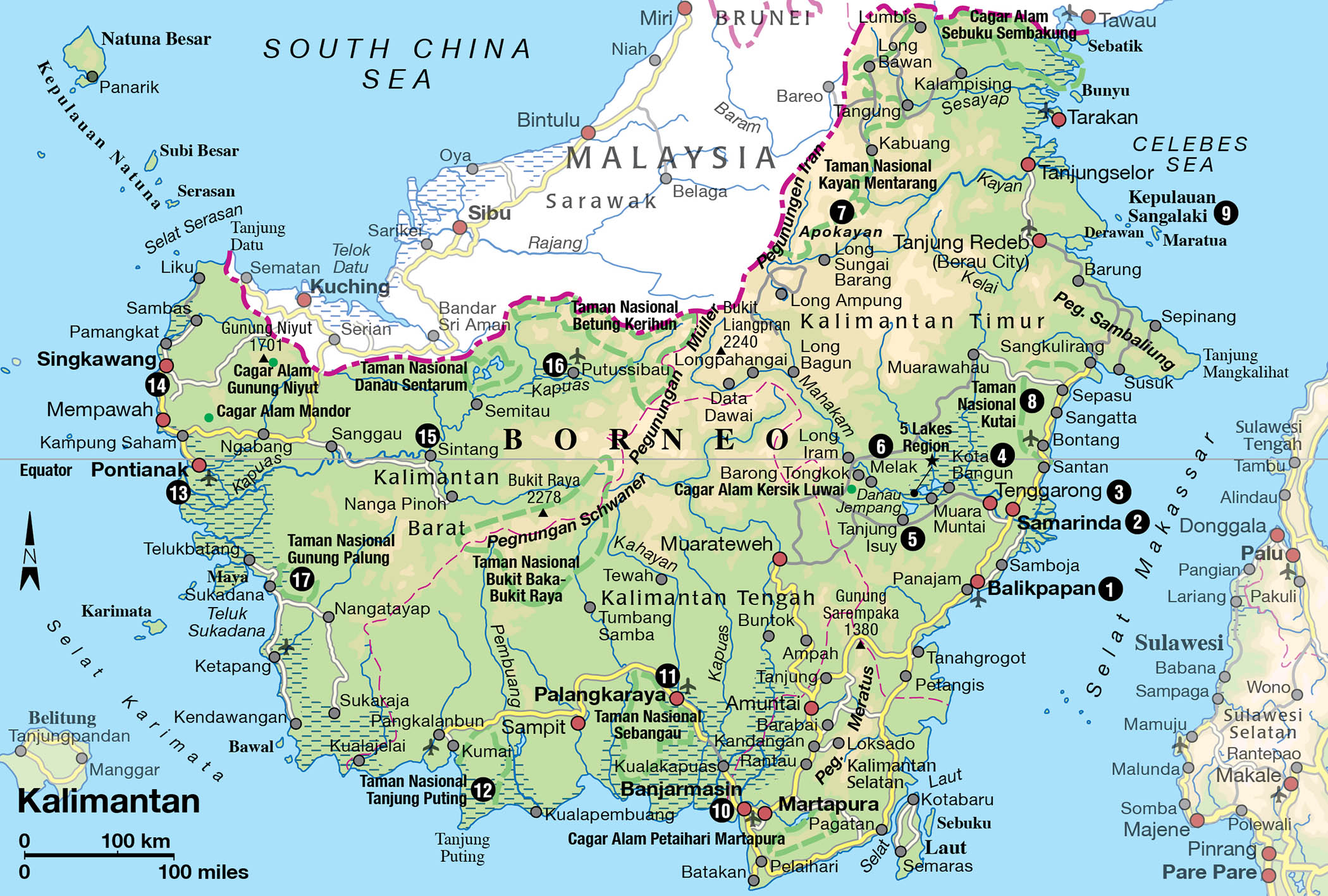Kalimantan Timur (East Kalimantan), or Kaltim for short, is the destination of choice for many ‘soft’ adventurers happy to travel by air-conditioned houseboat up Sungai Mahakam (Mahakam River) to see Dayak settlements, while doing a bit of wildlife spotting en route. For extreme trekkers, however, the possibilities are endless, with the only limitations being time, money and stamina.
Covering an area about the size of England and Scotland combined, the Sungai Mahakam and its tributaries criss-cross Kaltim, serving as ‘roads’ for a scant 2 million inhabitants. Many Dayak tribes – with their extended earlobes, communal dwellings and exquisitely beaded artwork – live inland, while on the coast remnants exist of two rival kingdoms that ruled from the 13th century until the last surviving sultan relinquished his authority to the Indonesian government in 1960.
Much smaller and far more densely populated, Kalimantan Selatan (South Kalimantan), or Kalsel, is separated from its two neighbouring regencies by the densely forested Meratus Mountain Range, with the Barito and Martapura rivers servicing the hinterland. Dayak tribes live upriver; on the coast, fringed by vast mangrove forests, are the primarily Muslim Banjar people, whose ancestors include Malays, Javanese, Arabs, Chinese, Buginese and Dayaks, as befits the people of an important trading port.
While Dayak tribes are not as plentiful here as they are in Kaltim, an adventure on the Sungai Amandit (Amandit River) makes Kalsel worth exploring, and Banjarmasin itself is a charming town.
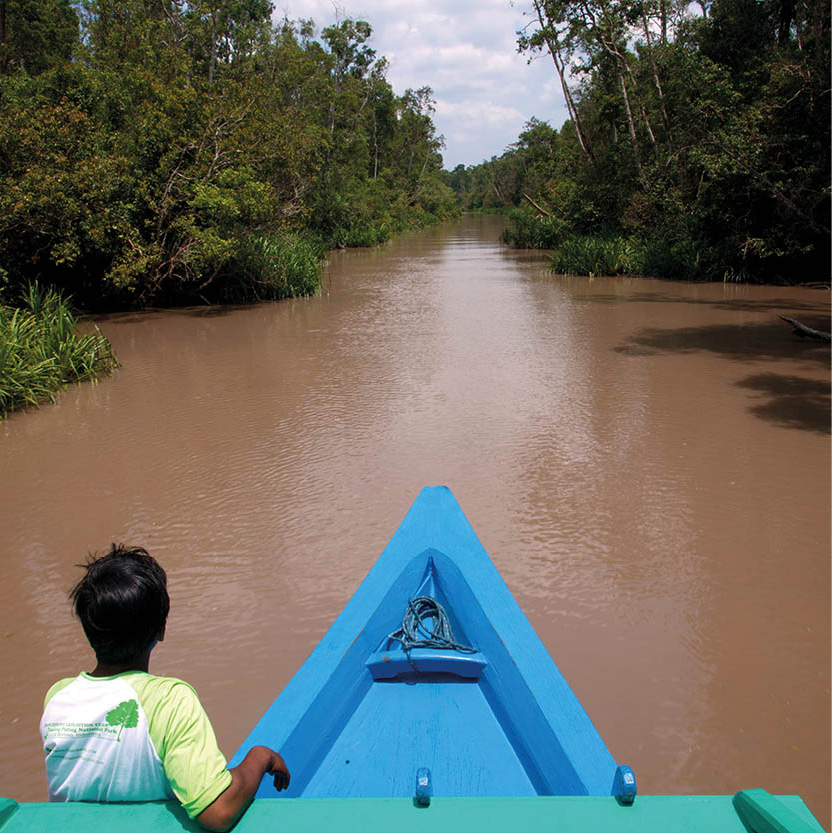
Local ‘klotok’ boat on Sekonyer River.
Getty Images
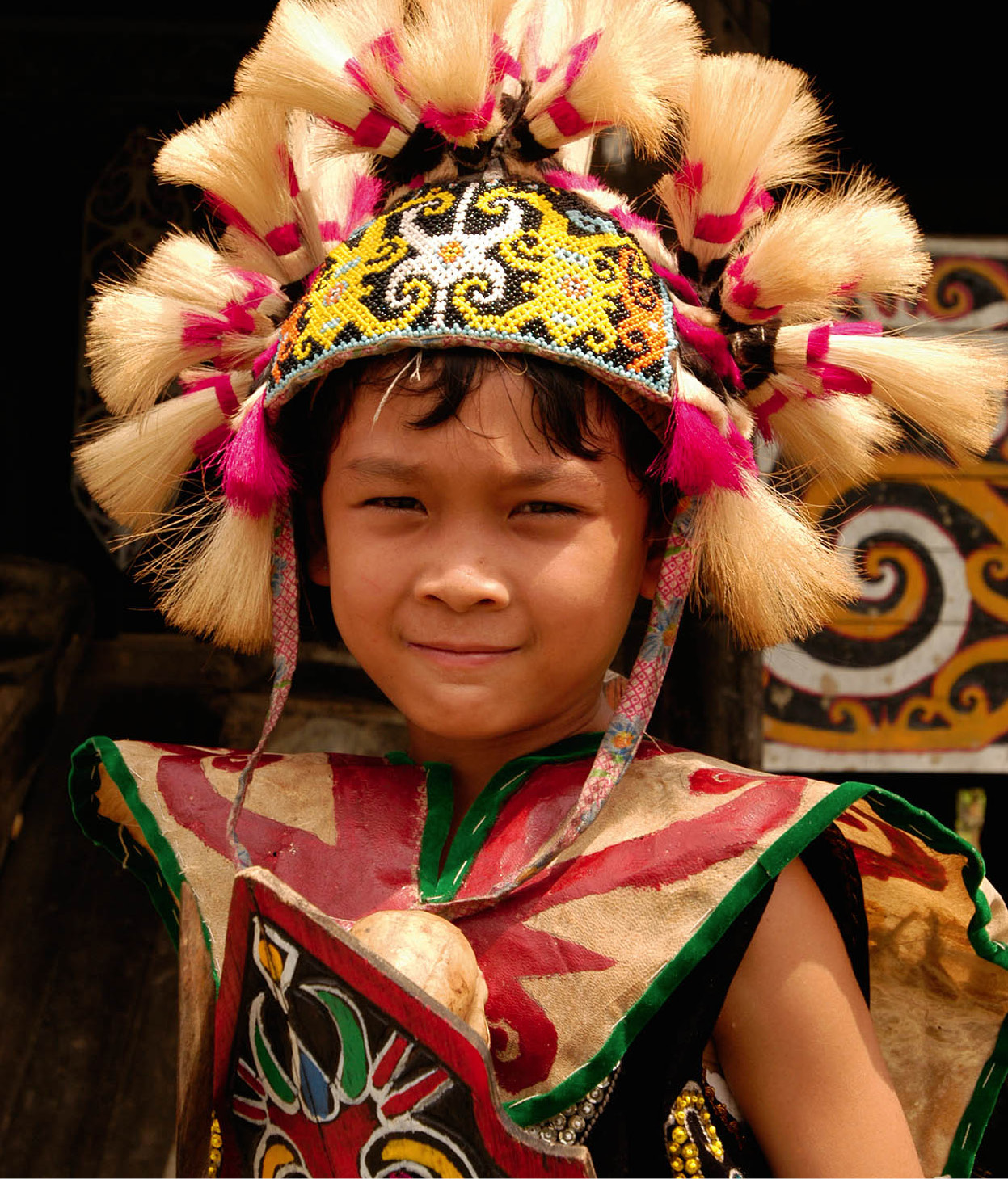
A Dayak boy in festival finery.
Indonesian Tourist Board
East Kalimantan
The usual port of entry to East Kalimantan is Balikpapan 1 [map], a busy oil and timber town with a population of 600,000. It’s not a place that holds great interest for travellers, who generally head straight to Samarinda by air or via the 115km (70-mile) paved road to begin their journeys up the great Sungai Mahakam.
Samarinda 2 [map] a similar-sized city, is the jumping-off point for visits to Dayak country and is the capital of Kaltim province. There is not much to see here aside from waterfront activity: freighters loading or discharging, coal barges being shoved around, rafts of logs under tow to nearby lumber mills. Half a day is enough in Samarinda, giving you time to check out timetables for planes or boats heading inland.
Sungai Mahakam trips
Sungai Mahakam is the main ‘highway’ into the hinterlands. Its source is in the Muller Mountain Range and from there it rushes, meanders, twists and turns downstream. Along the river are Dayak settlements, which are the major attraction for visitors. Also in the area are four lakes harbouring strange and wonderful animals, such as freshwater dolphins and Siamese crocodiles (Crocodylus siamensis).
Tour packages, arranged in Samarinda, are the best way to traverse the Mahakam, with some offering overnight stays either on houseboats or in longhouses set up for visitors. For all riverboats, the first major stop out of Samarinda is Tenggarong 3 [map], the former sultan’s capital, about 2–2½ hours away. En route, watch for sawmills and barges laden with coal – evidence of two of Kaltim’s major industries – and daily activities in riverside villages. There is a museum housing Ming-dynasty ceramics and Dayak handicrafts that is worth a visit.
Cruising the Mahakam River
The most popular way to reach Dayak country is by houseboat up the Mahakam River. Many tour operators offer packages, and they are more or less the same with a few basic differences. The first is the size of the boats: large ones for groups and smaller ones for individuals. Most are fully air-conditioned with Western toilets and hot-water showers, and they have two decks. Downstairs is a kitchen, where cruise meals are prepared, and a salon for dining and relaxing. Upstairs on the smaller boats is a sleeping room and a terrace, the larger boats have 10 cabins.
The main destinations of nearly all Mahakam cruises are Tenggarong, Muara Muntai, Danau Jempang, Tanjung Isuy, Mancong and the Melak area (Eheng and Kersik National Park). Nowadays houseboats cannot travel further upriver than Tering in mid-Mahakam.
One Samarinda tour operator, De’gigant Tours, includes Muara Pahu in its cruises due to the excellent wildlife spotting on the Bolongan River, with freshwater dolphins as the highlight. Stops at Dayak villages and watching life along the river are also attractions, as well as the changes of the river from vast and wide to narrow channels, while small hinterland villages are replaced by towns, and rather solitary travel becomes crowded with ships of all sizes getting ready to haul cargo through the Makassar Strait.
Alternatively, a new toll road links Samarinda to Tenggarong. The drive takes about 30 minutes, and the tour allows travellers to visit Tenggarong’s museum and then join a cruise boat for short trips on the Mahakam or longer trips upriver. Tenggarong is also home to the Erau festival, held every 22–28 September, celebrating the town’s founding and honouring former royalty. Dayaks come from miles away to perform traditional dances and recreate pagan rituals such as funeral ceremonies, contrasting greatly with the more sedate dances of the Kutai Muslims, who don their best ceremonial costumes for the occasion.
The next major stop, Kota Bangun 4 [map], lies 6 hours upstream from Tenggarong and is the last chance for accommodation with modern conveniences. From here, travellers can hire a motorised canoe into the upstream hinterland.
Riverside Muara Muntai, 2–3 hours from Kota Bangun, is home to both Kutai Dayak and transmigrants. It is also the departure point for exploring the mid-Mahakam lakes region, the beginning of Dayak country. Small motorised canoes can be rented here for the 2-hour run to Tanjung Isuy 5 [map], a Dayak village on Danau Jempang (Jempang Lake), sometimes called Green Lake due to massive amounts of a rampant water weed. Welcome rituals and dances are often performed for tourists here, the most popular destination in the Kaltim area. At Mancong village, a rebuilt lamin (longhouse) with 24 doors – the only two-storey longhouse in Kalimantan – gives an idea of past splendours. There has been a communal house on this site for more than 300 years.
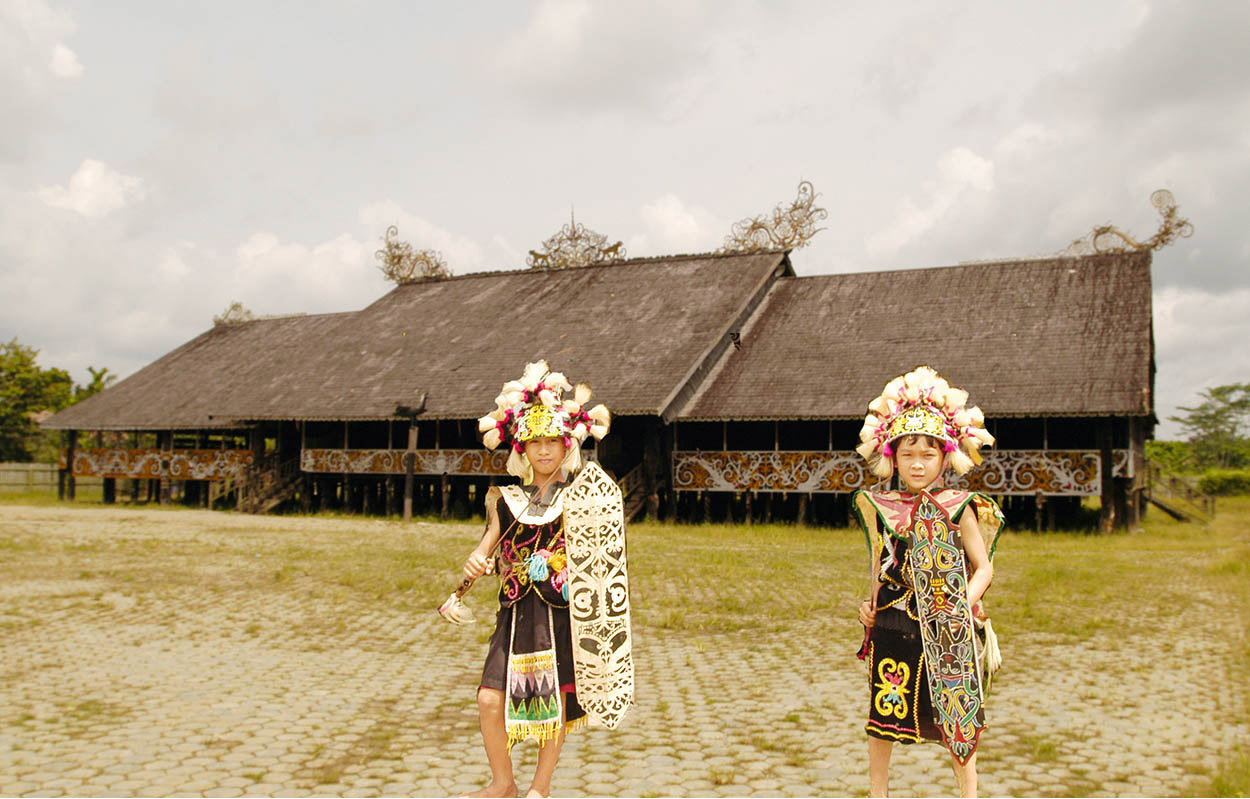
Dayak boys outside their village longhouse.
Indonesian Tourist Board
Danau Semayang, one of the two other lakes in the region, harbours freshwater dolphins and several bird species, such as lesser adjutants and egrets. Connected to Semayang is Danau Melintang, whose forested shores include leaf and unusual proboscis monkeys and at least 298 bird species. Siamese crocodiles are also found in this area.
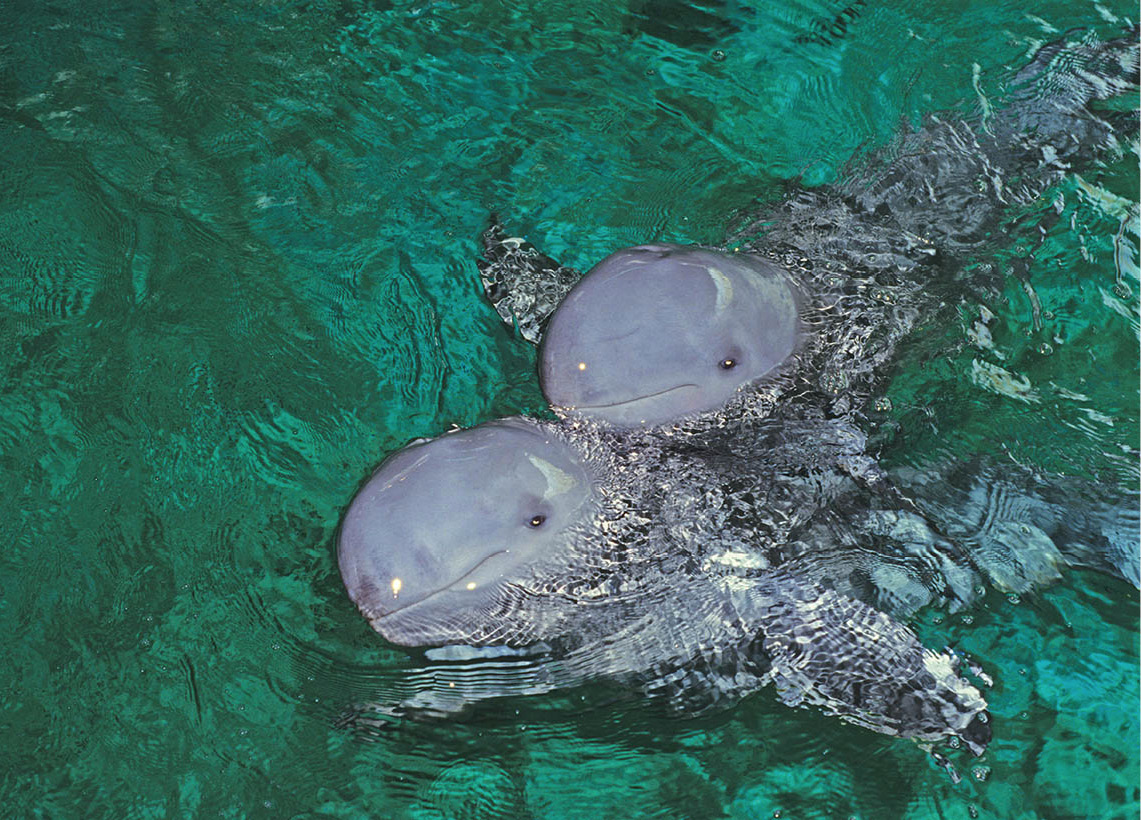
Freshwater dolphins in the Belongan River.
Photoshot
Dayak country
Melak 6 [map], the district capital, is a busy little town, and is home to the Tanjung Dayaks. There are lodgings and a modest restaurant, and local handicrafts are for sale. Downriver from Melak is the RASI Freshwater Dolphin Information Centre, located at the Bolongan River Delta at Muara Pahu. The centre supplies information about spotting freshwater dolphins.
There is a local road system out of Melak with transport (jeeps or motorcycles) for visiting the Kersik Luwai Nature Reserve, 10km (6.25 miles) to the south. The 5,000-hectare (12,355-acre) reserve is ideal for trekking, sheltering 100-plus species of orchids, including the famous ‘black’ variety, Coelogyne pandurata, which blooms April through December. Nearby Dayak villages Pepas Eheng and Ombau Asa have lived-in longhouses. Pepas Eheng can be reached in 1 hour by car from Melak. There’s a beautiful waterfall, Jentur Gemuruh, at Ombau Asa. Ask around if you wish to witness a funeral ceremony in progress; the rituals feature the sacrifice of a water buffalo performed with spears.
Upriver from Melak is Barong Tongkok, where the nearest authentic longhouses are located. Beneath the T-shirts and shorts worn by most villagers in the area beat the hearts of followers of the traditional religion, Kaharingan (meaning ‘life’). Influenced by Hinduism, Kaharingan focuses on the supernatural world, and involves ritual practices such as shamanic curing. A nice place to overnight, Barong Tongkok has lodgings, shops and motorcycles to take visitors to other Dayak villages. Between Barong Tongkok and Tering is an ancient megalithic site reachable by trekking 40km (25 miles).
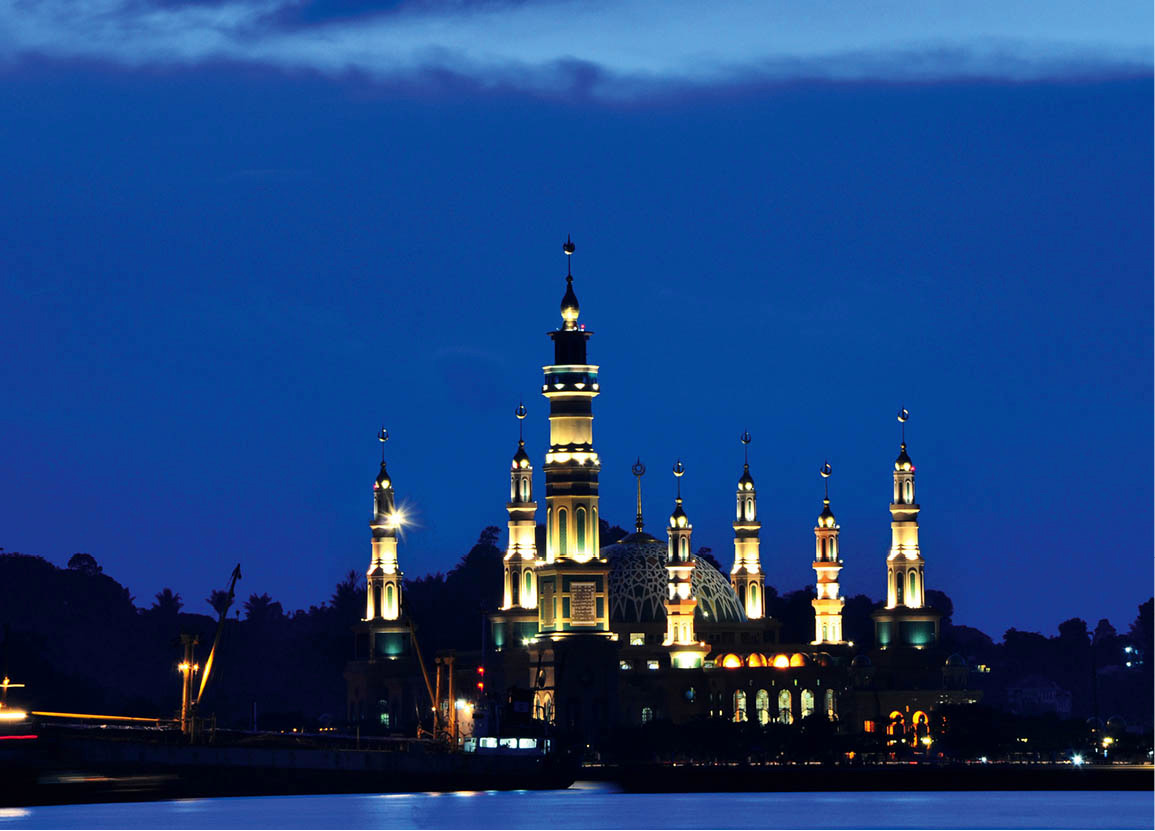
The Islamic Centre at Samarinda.
Fotolia
Six hours upstream from Melak, year-round river navigation stops at Long Iram, more than 400km (250 miles) from the coast. Some of the larger passenger boats make the Samarinda–Long Iram run in about 36 hours, have bunks and mattresses for a small surcharge, and kitchens serving simple meals. Several larger riverside towns offer basic accommodation, and their restaurants serve rice-based meals. Beyond Long Iram, there is only the hospitality of the Dayaks or government officials. Many of the Dayaks in this area, and also further upstream, belong to the Roman Catholic Church, which tolerates and even encourages some traditional rituals.
If the river level is not too low, boats can reach Long Bagun in 4–6 hours from Long Iram. Several Dayak groups are settled along this stretch of the Mahakam, including the Kenyah, who are known for their huge sculptures and paintings in communal buildings.
Beyond Long Bagun, logistics are a problem because a series of rapids choke off most river travel, with only an occasional powerful twin-outboard longboat roaring through. Chartering a boat may entail a long wait. It is a great experience, but unless you have plenty of time, the best way to reach the uppermost areas of the Mahakam is to fly from Samarinda to Data Dawai, a landing strip near Long Lunuk village. From Data Dawai, charter a boat to go upriver to Long Apari, the last village on the Mahakam.
Tip
Travel in Kalimantan is expensive because, due to poor infrastructure, several forms of transport must be chartered to get from one place to another. Take plenty of time, money and patience, and prepare for the adventure of a lifetime.
The Apokayan region
Near the border with Sarawak, the forested highlands of the Apokayan region 7 [map] are relatively untouched by time. The isolated Kenyah residents are some of the most traditional Dayaks in Kalimantan. Travel to this area is not for the casual tourist, but for adventurers it offers a glimpse of one of Indonesia’s most remote regions.
Currently air travel is the only means of access, other than weeks of trekking. Be warned that flights are often delayed or cancelled, and it is advisable to avoid this scenario if time schedules are tight. On the bright side, roads to Apokayan are now under construction, and in time the area will be more accessible.
Located on the uppermost reaches of the Sungai Kayan, a dozen villages are strung out on either side of the landing strip at Long Ampung. Due to its isolation and difficulty in obtaining essentials, most Apokayan inhabitants have migrated to more accessible locations. Those who remain usually live in longhouses, and the prolific artwork of the Kenyah is still in evidence. There are good trails for trekking, and distances between villages can be covered in a few hours or by boat on small rivers.
Among the highlights is Long Uro, a 2-hour walk from Long Ampung, where there are Dayak carvings in front of the village and a cemetery. An easy hour’s walk away is Long Lindung Payau, with ancient stone relics.
The last human settlement on the Sungai Kenyah, Long Sungai Barang, is a demanding 4-hour walk over hills and through jungle. On a lake surrounded by mountains, Long Sungai Barang is an excellent place to rest for a few days and gather strength for the trip back to ‘civilisation’.
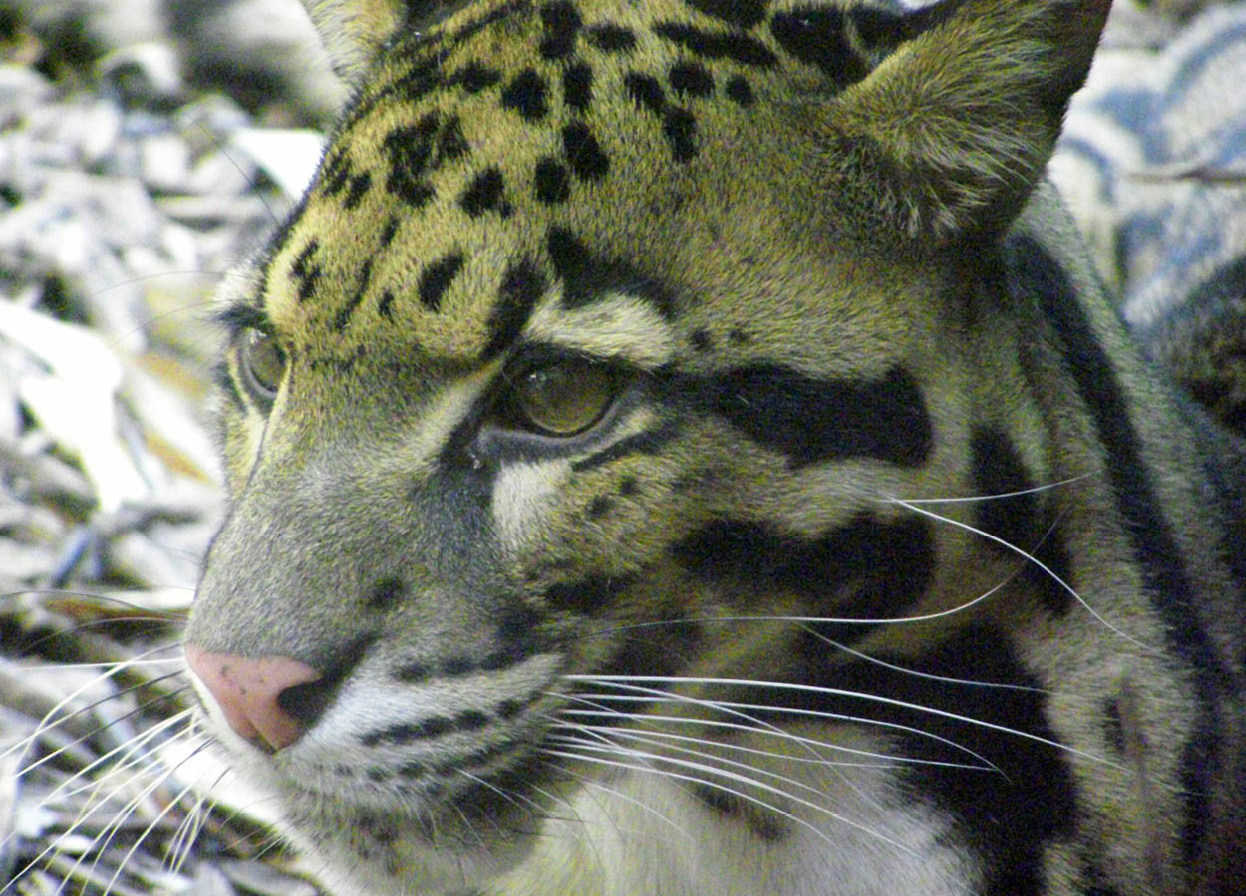
A clouded leopard.
Frank Wouters
Kayan Mentarang National Park
In the heart of the Apokayan region is Kayan Mentarang National Park, 13,605 sq km (5,253 sq miles) of untouched rainforest, the largest block of its kind on Borneo. The park protects a wealth of flora and fauna, many species of which are endemic. Much of the park is lowland and hill forest populated by Dipterocarp trees, while the remainder is cloud forest.
Wildlife, including pangolins, proboscis monkeys, slow lorises and tarsiers, three hornbill species and Bulwer’s pheasants, may be difficult to spot due to hunting by the several thousand Dayak people who live here. The WWF has five regional field offices and a research station at Long Alango that can help with information.
Tip
Changing foreign currency into Indonesian rupiah can be difficult in Kalimantan. Therefore, it’s best to handle these financial matters before arriving.
Inside the park are the Krayan Mountains, near Long Bawan. Krayan forms a plateau 1,700 metres (5,570ft) above sea level where ancient, impenetrable cloud forest with dense undergrowth and sandstone valleys dominates. Further east, Sebuku Sembakung is a protected area where rarely seen pygmy elephants reside.
Access to the area is difficult due to its remote location, and trips are expensive. It is essential to make arrangements with a local tour operator. Small aircraft do fly into the area, but they require booking one month prior to departure.
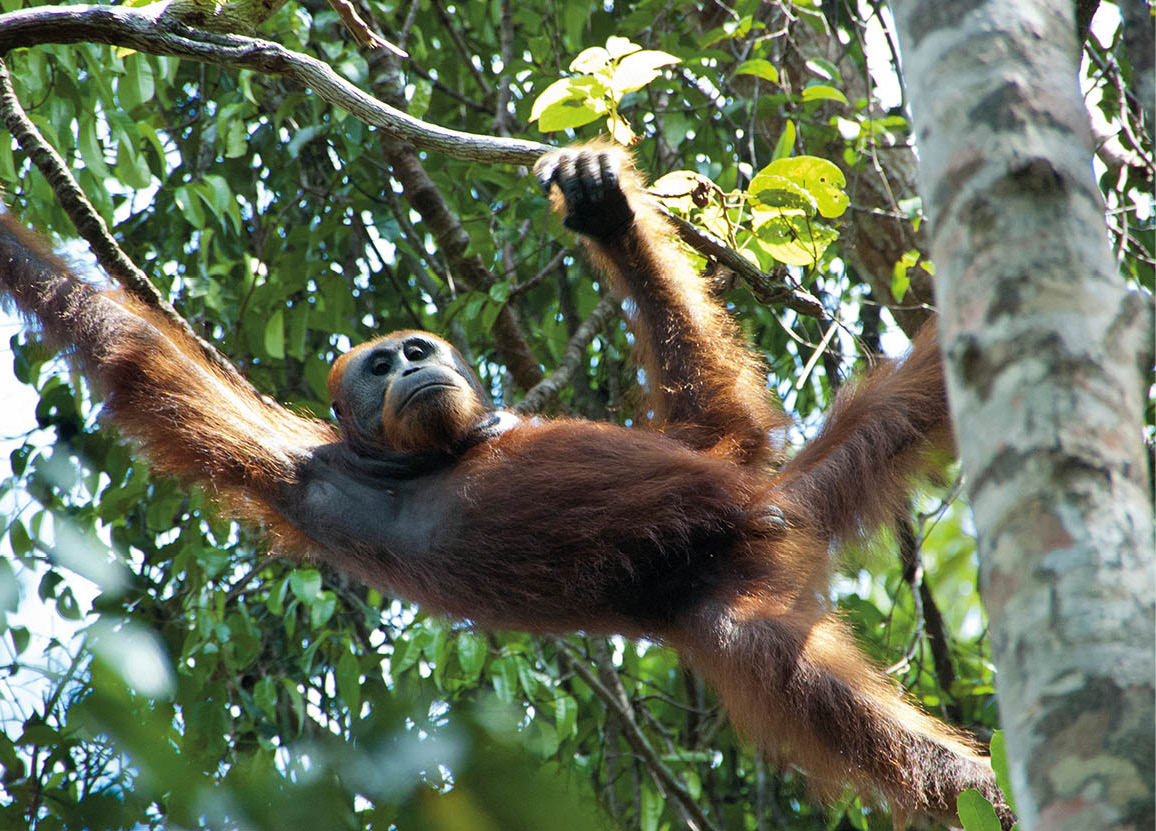
An orang-utan at Kutai.
iStock
Kutai National Park
On Kaltim’s east coast, the principal attraction at Kutai National Park 8 [map] is orang-utans. There are another 60 mammal species and 300 species of birds here, including proboscis monkeys, clouded leopards, tarsiers and hornbills, as well as monitor lizards, crocodiles and pythons.
To reach the park, travel from Balikpapan either by road (about 300km/186 miles, 6–7 hours), by bus to Sangatta village (1–1.5 days), or fly from Balikpapan to Bontang, the site of a natural gas plant on the coast. At Bontang, report to the park office for a permit before beginning your journey. From Bontang, take a motorised canoe to riverside Sangatta for the best wildlife viewing. Park facilities are limited to two basic rooms. Nearby is excellent birdwatching, the only place in Kalimantan where eight hornbill species can be spotted.
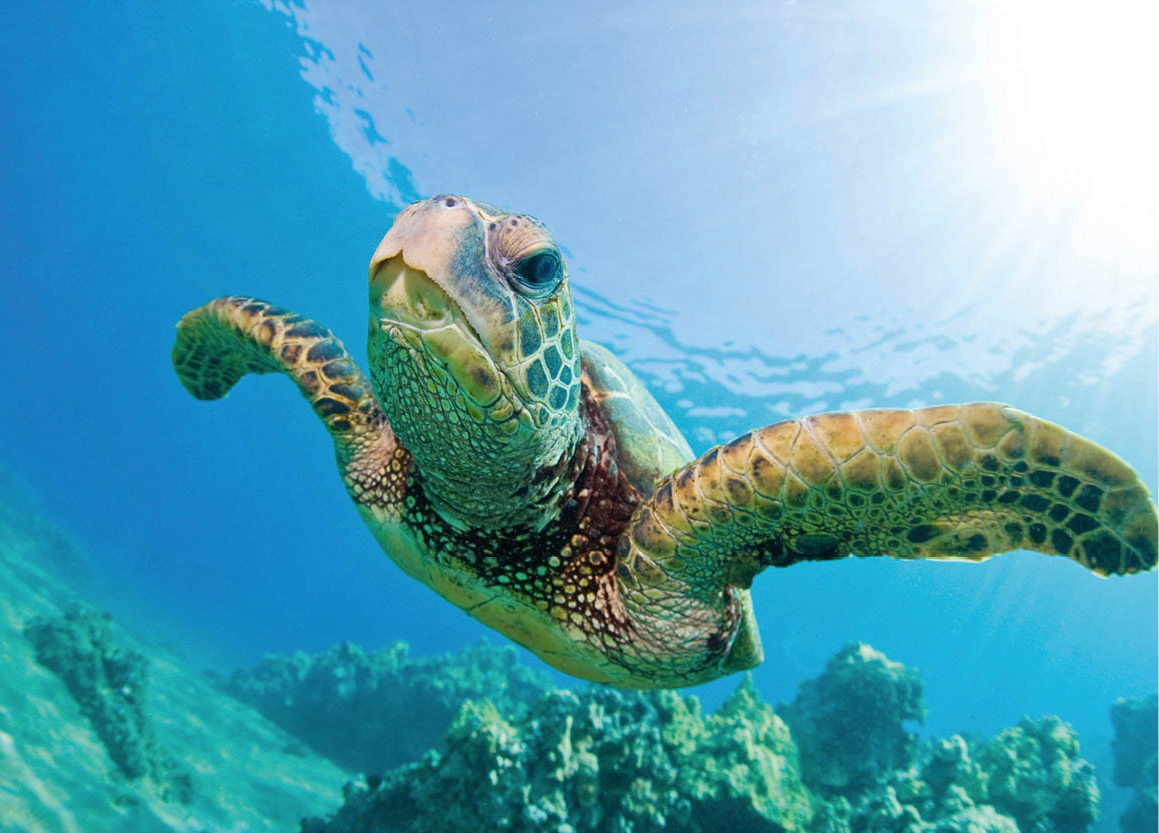
A green turtle.
iStock
North of Bontang, Tanjung Redeb (Berau) is the entry point to the Sangalaki archipelago 9 [map], which is growing in popularity as a dive destination. The town itself is nothing to brag about, but there is a replica of the Gunung Tabur palace across the river, now a museum, which was damaged by Japanese bombs during World War II.
The archipelago consists of several islands, and the sea gardens here are spectacular, with several hundred species of reef fishes and corals, dugongs, lobsters and endangered sea turtles. Several varieties of dolphins are also prolific here, and humpback and other whales frequent deeper waters.
At Derawan there is a WWF-sponsored sea turtle sanctuary. To reach it, fly from Balikpapan into Tanjung Redep and go overland to Tanjung Batu (about 2 hours). From here it is 30 minutes by speedboat to Derawan, where there is a dive resort.
Palm-fringed Nabucco island, with white-sand beaches, also has a dive resort. A 30-minute boat ride takes you to Big Fish Country, inhabited by barracuda, sharks, rays, groupers and bumphead parrotfish. Water-skiing and wakeboarding are also available here. A resort on Maratua island offers water-skiing and diving.
Tip
Travelling solo in Kalimantan requires fluency in Bahasa Indonesia, the national language, because so few people here speak English. It is highly recommended to arrange expeditions through a licensed tour operator who can provide an English-speaking guide.
Sangalaki island’s main diving draw is manta rays, which feed on plankton north of the islands. The reefs here are 4–40 metres (13–130ft) deep and there is a shipwreck, attracting scorpionfish, jawfish, frogfish and ribbon eels. A local foundation that protects green turtles allows visits to the hatchery and to the beach to see turtles laying eggs at night.
Nearby is Wehea, a Dayak community that set up a small ecotourism business with money received in settlement from a logging company dispute. There is a lodge and campsite, and canoes are available for wildlife spotting and village visits. At least 600 orang-utans inhabit the forest here.
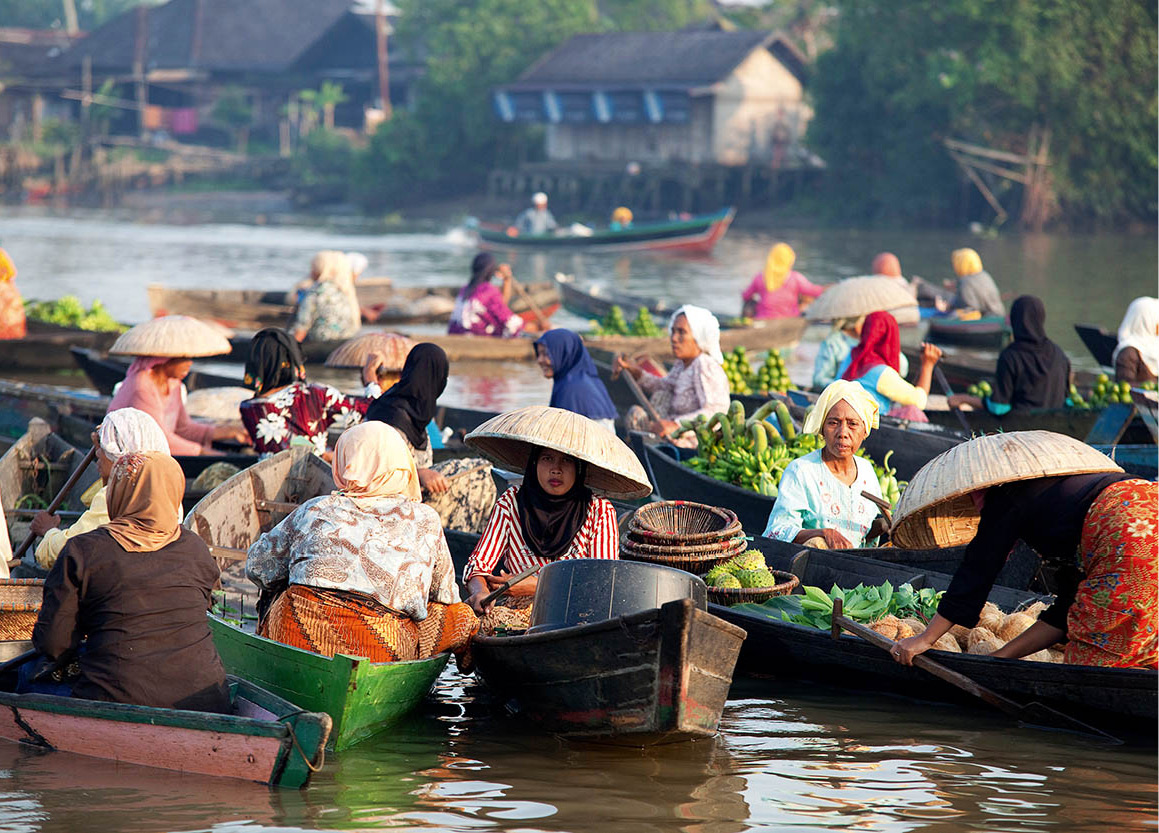
A floating market near Banjamarsin.
Corrie Wingate/Apa Publications
South Kalimantan
Kalimantan Selatan (Kalsel), often called the ‘Land of a Thousand Rivers’, is a small, swampy province on the southeast coast. There are frequent flights to the capital city, Banjarmasin ) [map], interesting for its colourful floating markets and bustling canals. The majority of Kalsel’s people are Banjarese. Largely Muslim, with a sprinkling of Protestants and Catholics, the Banjarese are strict adherents to their religion, with thousands making the pilgrimage to Mecca each year. Modest dress is required while travelling in the region.
Criss-crossed by rivers and tributaries, Banjarmasin teeters at the brink of sea level, dipping below that when the tide is in. Perched on the banks of the intersection of the Martapura and Barito rivers, floating houses line the waterways, water taxis ply the riverine ‘highways’, and jukung (dugout canoes) replace street-side shops.
There are a couple of places (under the Yani Bridge and at Kuin Pertamina) to rent a klotok (motorised canoe) to tour the Sungai Barito. Start early to visit one of the charming floating markets. Pasar Terapung, 30 minutes from town, is the most famous and has been bobbing along the Sungai Kuin for 400 years. It gets under way before dawn and the activity peters out a couple of hours after sunrise. Female vendors glide through the canals in canoes selling fruit, vegetables and fish or light refreshments to housewives whose front (or back) doors open onto the water.
Closer to town, the Martapura or the Barito are good places to experience riverside life at its bustling best. Take a klotok or a bis air (water bus) up a branch of the Sungai Martapura just beyond the Trisakti docks – which are for large ships – to see a modern lumber mill, where cranes lift enormous felled trees out of the river. A short way up the Martapura, open-fronted stores sell brightly coloured plastic items to water-borne shoppers. Housewives gossip and exchange pleasantries as they handle laundry chores, while naked children bathe.
A bit further on, graceful Bugis-style schooners (pinisis) are constructed from sturdy ironwood along the riverbank. Just beyond, there is an all-night fish market and a red-light district. Sunsets on the rivers can be bewitching.
The ultra-modern Mesjid Raya Sabilal Muhtadin (Grand Mosque) rests on land formerly occupied by a Dutch fortress and is one of Asia’s largest places of worship. Its metallic flying saucer-shaped dome is clearly visible from the river. Inside, beautifully finished stone panels with copper inlaid inscriptions from the Koran line an open space for praying. Doors and windows are decorated with reliefs taken from traditional Banjarese designs. As when visiting any mosque, dress modestly (women should have their knees, midriffs and arms covered), and remove footwear before entering.
Fact
Kalimantan is the only place in Indonesia where diamonds are found. As early as the 1500s, Kalimantan’s diamonds had earned a reputation for their brilliance and purity.
Gemstones and gold panning
At Cempaka, about 45km (28 miles) from Banjarmasin, workers dig shafts 10–15 metres (33–49ft) deep, shored up with bamboo scaffolding and fitted with steps, where men wait down-hole to pass baskets of soil, clay and gravel to the surface. The search is for gems, and they hope to duplicate the 1965 find of the 100-plus-carat Trisakti Diamond. Attentive women puddle the dirt, sift it through a screen, then pan it, watching with experienced eyes for even the smallest diamonds, sapphires, amethysts, garnets and gold. In nearby Martapura, the gems are cut and polished. Some stones purchased in this area have been appraised in the West at a higher value than that which was paid. Shopping with reputable dealers is advised, paying particular attention to quality.
For another look at mining, 65km (40 miles) southeast of Banjarmasin in Pelaihari is a gold-mining region started by Chinese settlers at the request of the Banjar sultan six centuries ago.
Sungai Amandit
Itineraries on the Sungai Amandit range from half- to 2-day trips poling downriver by bamboo raft from Loksado through white-water rapids past scenic mountains. The river originates in Gunung Meratus, flows through Loksado and meets the Barito further downstream. Treks at Meratus can also be arranged.
The Amandit can be navigated in two segments: from Loksado to Muara Hatip, near Kandagan (Class 1–2.5 rapids), including a night’s stay at a simple lodge at Muara Hatip. Stage two is from Muara Hatip to Batu Laki, where the rapids increase to Class 3 at the mouth of the Sungai Muara Harang.
Getting to Loksado, 40km (25 miles) east of Kandangan, and Dayak country, is not for the faint-hearted. Twenty-four kilometres (15 miles) east of Kandangan is Lumpangi, which can be reached by car in about 2 hours. From here, Loksado (Muara Hatib) can only be reached by trekking about 4 hours over mountains, through forests, and across hanging bamboo bridges.
There are about 20 longhouses around Loksado, but they do not have the long verandas seen in other parts of Kalimantan although the concept is the same. They can house 10 families or as many as 120 people. Aruh Ganal, a tribal ceremony, is held during the harvest season. The reward for the arduous journey is seeing nature at its best, with 500 bird species, 150 snake species, and many other reptiles, amphibians and several hundred varieties of freshwater fish.
Sungai Amandit can also be reached by car via Kandangan, continuing by local public transport in approximately 6 hours or by chartered car in about 4 hours.
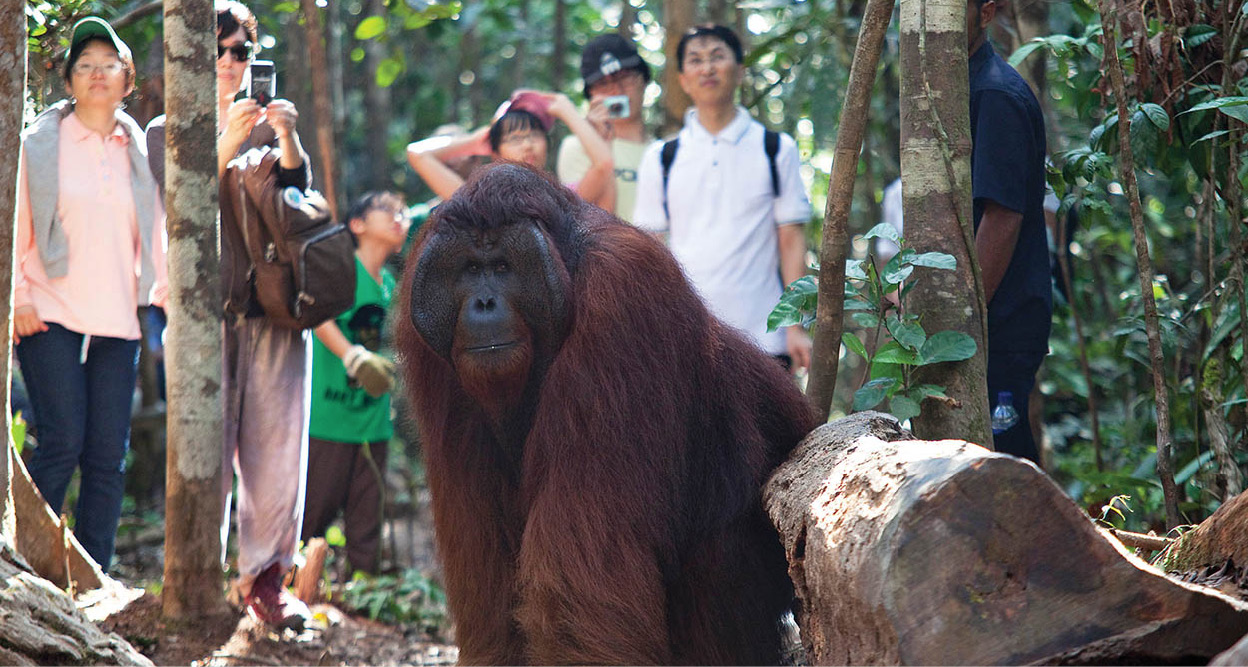
Seeing orang-utans in the wild is a highlight of any trip to Indonesia.
Corrie Wingate/Apa Publications
Orang-utans: The fight for survival
At orang-utan rehabilitation centres across Kalimantan, the race is on to protect the apes’ habitat from deforestation and to educate the community.
Orang-utans have grabbed world headlines not only for their endangered status but also because their numbers have dropped dramatically over the last few decades. With only two subspecies, one in Sumatra and the other in Borneo, scientists and activists have latched on to the cause with great vigour, drawing attention to Indonesia’s poor forest-management practices in the process. In the past, poaching was the greatest threat due to the high prices their cute young faces and intelligence commanded from private individuals, zoos and theme parks. Today, the larger culprit, as for most protected species, is dwindling habitat caused by fires, logging and forest-clearing for commercial plantations.
In the wild, an infant orang-utan stays with its mother for the first seven to eight years of its life. During this time, it learns to distribute its weight while moving through the trees, to build a fresh sleeping nest each night, and to identify edible forest foods.
Indonesia’s first rehabilitation centre was established in Sumatra in 1971, and since then several others have been created as surrounding release sites reached capacity. The best known of these centres is Camp Leakey in Tanjung Puting National Park, Central Kalimantan. The centres’ jobs are to teach the orang-utans basic skills so they can survive in their jungle habitats, and to release them back into the wild.
Whether or not orang-utan rehabilitation programmes are successful is debatable, but through their work they attract global attention to the problem, thereby forcing state and local officials to take action. Nowadays, in addition to orang-utans, most centres focus on protecting remaining forests and replanting which, in turn, helps to secure the futures of hundreds of other species that play vital roles in forest ecosystems. Efforts also include community development: providing jobs – thus financial stability – and environmental education.
Borneo Orang-utan Survival Foundation
One especially noteworthy project is at Samboja Lestari, 40 minutes from Balikpapan, East Kalimantan, an area severely devastated by drilling for oil, logging and forest fires. Operated by award-winning Borneo Orang-utan Survival Foundation (BOS), in addition to reforestation, rehabilitation and community involvement, they operate a Sun Bear Sanctuary. Sun bears are hunted for their gall bladders, claws, teeth, skins, skulls and paws.
BOS also manages several other forest and wildlife reserves in Kalimantan, a primate conservation education programme in Jakarta and a satellite monitoring centre that keeps track of deforestation, commercial plantations and illegal logging. Visitors are welcome at its Samboja Lodge – all revenues go to BOS conservation projects – which also offers trekking excursions into virgin rainforest in search of wild orang-utans, to orang-utan ‘islands’ and into nearby Dayak tribal villages. There are also volunteer opportunities aplenty for those who want to be more deeply involved. For further information, visit www.sambojalodge.com.
